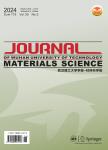Behavior of Stress Corrosion Cracking in a Magnesium Alloy
Behavior of Stress Corrosion Cracking in a Magnesium Alloy作者机构:The MOE Key Laboratory of Mechanical Manufacture and Automation Zhejiang University of Technology
出 版 物:《Journal of Wuhan University of Technology(Materials Science)》 (武汉理工大学学报(材料科学英文版))
年 卷 期:2009年第24卷第1期
页 面:111-113页
核心收录:
学科分类:08[工学] 080502[工学-材料学] 0805[工学-材料科学与工程(可授工学、理学学位)]
基 金:Funded by the National Natural Science Foundation of China (No.50771093)
主 题:magnesium alloy stress corrosion cracking slow strain rate testing (SSRT)
摘 要:Slow strain rate testing (SSRT) was employed to study the stress corrosion cracking (SCC) behavior of ZE41 magnesium alloy in 0.01 M NaCl solution. Smooth tensile specimens with different thicknesses were strained dynamically in both longitudinal and transverse direction under permanent immersions at a strain rate of 10-6 s-1. It is found that ZE41 magnesium alloy is susceptible to SCC in 0.01 M NaCl solution. The SCC susceptibility of the thinner specimen is lower than that of the thicker specimen. Also, the longitudinal specimens are slightly more susceptible to SCC than the transverse specimens. The SCC mechanism of magnesium alloy is attributed to the combination of anodic dissolution with hydrogen embrittlement.



